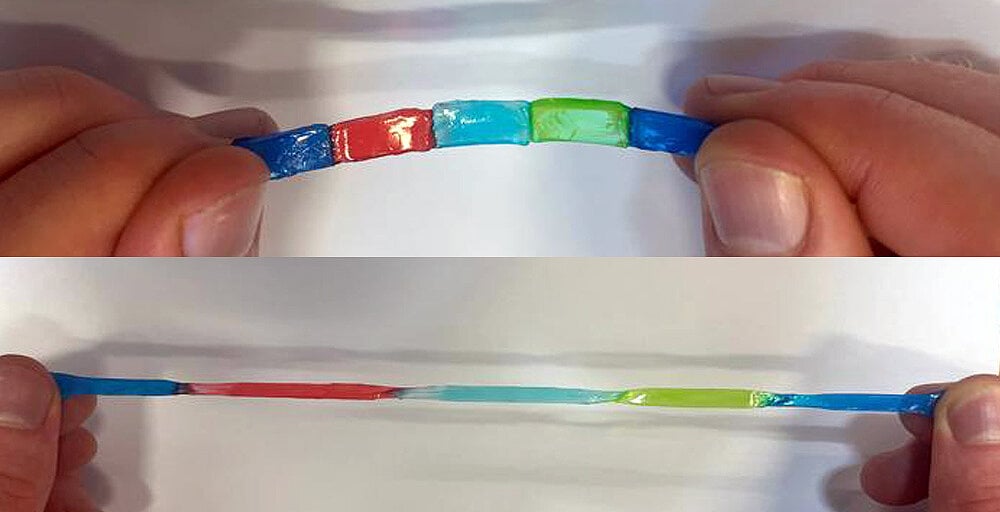Two research teams have independently developed flexible batteries that can be stretched and deformed without losing functionality, potentially revolutionizing power sources for wearable technology and biomedical implants.
A team from Nanjing University in China created a lithium-ion battery that can stretch up to 5,000 percent of its original length. The researchers said it opens up “a new avenue for the development of stretchable energy storage devices.”
According to a report from the American Chemical Society, wearable or implantable devices demand flexible power sources, and prior approaches have relied on woven fabrics or folding components like “origami.”
“For a truly malleable battery, every part—the electrodes that collect charge and the charge-balancing middle electrolyte layer—must be elastic,” the report noted, adding that using a fluid also has challenges. So the team developed a special polymer.
Image: Nanjing University
In a brief summary of their experiment, the team explains that it used materials like ethylene glycol, methyl ether acrylate and silver nanowires to create electrodes that can be transferred to a flexible substrate. They also synthesized a superior stretchable polymer electrolyte to fabricate the batteries, which demonstrated excellent mechanical properties and electrochemical performance.
“The electrode can light an LED at initial and 100% strain states, due to the high electronic conductivity,” the researchers observed. The team shared an image of a battery-powered LED remaining illuminated both before and after stretching.
While promising, the Nanjing University prototype currently maintains health through about 70 full charge cycles, significantly fewer than the 300-500 cycles typical of standard lithium-based batteries before performance degradation begins.
“There are still improvements to be made, but this new way of creating fully stretchable, solid batteries could be a promising step forward for wearable or implantable devices that flex and move with the body,” the report concludes.
Inspired by eels
Meanwhile in the U.K., researchers from the University of Cambridge published findings on their own flexible power sources, describing them as “jelly batteries.” The approach was inspired by electric eels, mimicking the layered structure of their electrocytes—organic flexible tissues capable of conducting electricity.
“It’s difficult to design a material that is both highly stretchable and highly conductive, since those two properties are normally at odds with one another,” said lead author Stephen O’Neill in a press release.
The Cambridge team’s batteries utilize hydrogels, three-dimensional networks of polymers containing over 60% water. These structures can also stretch and return to form without losing functionality.
“Here, we synthesize supramolecular polyionic networks, which display high stretchability (>1,500%), compressibility (>90%), and rapid self-recovery,” the project’s research paper reads.
The jelly batteries’ layers adhere strongly due to reversible bonds formed by the compound’s molecules.
 Image: University of Cambridge
Image: University of Cambridge
“The supramolecular cross-links enabled the layered specimens to be elongated by more than 10 times their initial length before fracturing at the interface,” the paper explains.
Team lead Oren Scherman, a professor and director of the Melville Laboratory for Polymer Synthesis, collaborated with O’Neill and Professor George Malliaras from the university’s engineering department.
“We can customize the mechanical properties of the hydrogels so they match human tissue,” Scherman said in the release. “Since they contain no rigid components such as metal, a hydrogel implant would be much less likely to be rejected by the body or cause the build-up of scar tissue.”
The Cambridge team suggests their jelly batteries could also be implanted in the brain to deliver drugs or treat conditions such as epilepsy. Beyond their flexibility, the hydrogels demonstrate remarkable toughness, able to withstand compression without permanent deformation and capable of self-healing when damaged.
The development of these technologies is a global priority. The World Economic Forum recognized flexible batteries as one of the “Top 10 Emerging Technologies” of 2023. The advancements promise to expand possibilities in fields such as wearable devices, Internet of Things applications, flexible smartphones, and brain-computer interfaces (BCI).
Edited by Ryan Ozawa.
Generally Intelligent Newsletter
A weekly AI journey narrated by Gen, a generative AI model.
Source: https://decrypt.co/240550/flexible-batteries-wearables-neurotechnology


